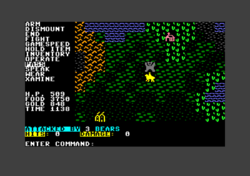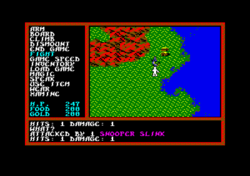
Questron
Encyclopedia
Questron is a fantasy
RPG computer game series produced by Strategic Simulations, Inc.
 In Questron the player takes on the role of a young serf who tries to make a name for himself by traveling the realm in order to gain the power and experience necessary to defeat the wicked "Mantor", ruler of the "Land of Evil".
In Questron the player takes on the role of a young serf who tries to make a name for himself by traveling the realm in order to gain the power and experience necessary to defeat the wicked "Mantor", ruler of the "Land of Evil".
The gameplay and graphics are very simple. The view is mostly in top-down style for the world maps and town encounters, but switches to a 3D first-person style in the dungeons of the Land of Evil.
Some features were novel for a game of its type at the time of its release. First there are two "games within a game" that allow the character to permanently increase dexterity or intelligence attributes if completed successfully. Also, various casinos about the towns allow the player to gamble for gold pieces in games of Blackjack
, Roulette
or "Double or Nothing".
The moral tone of the game is strange. You can rob and kill merchants, and to progress in the game to the Land of Evil you must storm a castle and kill the guards. The king of that castle will knight you for your courage.
Another aspect of the game is that various monsters and foes are immune or more vulnerable to different weapons. The player would occasionally have to switch weapons depending on which enemy they faced in order to defeat them. Magic spells can also be cast, but only in the dungeon levels.
The original game was written by Charles Dougherty and Gerald Wieczorek and published in 1984 for the Commodore 64
and Apple II
computer systems. The structure and style of the game were licensed from Richard Garriott
, author of Akalabeth
and Ultima. This game was the first foray by SSI into the fantasy RPG genre and its release was followed by the more expansive Phantasie
series.
 In 1988 a sequel was made for the Apple IIGS
In 1988 a sequel was made for the Apple IIGS
, Commodore 64 and Amiga
computers. It featured gameplay of a similar style with improved graphics and features. This game's programming and artwork are credited to Westwood Associates, while the storyline and original design are credited to Quest Software. This game was also produced by Strategic Simulations, Inc.
The premise of this game is that the player's character has been sent back in time to defeat six "Mad Sorcerers" before they can create the "Book of Magic" featured in the original game.
in 1987 for the Apple II & Commodore 64 (and later the PC), followed by its sequel Legend of Blacksilver in 1988. Both games used an updated version of the engine used by Questron.
described Questron II as very similar, albeit not equal, to the original.
Questron II was reviewed in 1988 in Dragon
#138 by Hartley, Patricia, and Kirk Lesser in "The Role of Computers" column. The reviewers gave the game 4 out of 5 stars.
Phantasie I, Phantasie III, and Questron II were later re-released together, and reviewed in 1994 in Dragon
#203 by Sandy Petersen
in the "Eye of the Monitor" column. Petersen gave the compilation 2 out of 5 stars.
Fantasy
Fantasy is a genre of fiction that commonly uses magic and other supernatural phenomena as a primary element of plot, theme, or setting. Many works within the genre take place in imaginary worlds where magic is common...
RPG computer game series produced by Strategic Simulations, Inc.
Strategic Simulations, Inc.
Strategic Simulations, Inc. was a video game developer and publisher with over 100 titles to its credit since its founding in 1979. It was especially noted for its numerous wargames, its official computer game adaptations of Dungeons & Dragons, and for the groundbreaking Panzer General...
Questron

The gameplay and graphics are very simple. The view is mostly in top-down style for the world maps and town encounters, but switches to a 3D first-person style in the dungeons of the Land of Evil.
Some features were novel for a game of its type at the time of its release. First there are two "games within a game" that allow the character to permanently increase dexterity or intelligence attributes if completed successfully. Also, various casinos about the towns allow the player to gamble for gold pieces in games of Blackjack
Blackjack
Blackjack, also known as Twenty-one or Vingt-et-un , is the most widely played casino banking game in the world...
, Roulette
Roulette
Roulette is a casino game named after a French diminutive for little wheel. In the game, players may choose to place bets on either a single number or a range of numbers, the colors red or black, or whether the number is odd or even....
or "Double or Nothing".
The moral tone of the game is strange. You can rob and kill merchants, and to progress in the game to the Land of Evil you must storm a castle and kill the guards. The king of that castle will knight you for your courage.
Another aspect of the game is that various monsters and foes are immune or more vulnerable to different weapons. The player would occasionally have to switch weapons depending on which enemy they faced in order to defeat them. Magic spells can also be cast, but only in the dungeon levels.
The original game was written by Charles Dougherty and Gerald Wieczorek and published in 1984 for the Commodore 64
Commodore 64
The Commodore 64 is an 8-bit home computer introduced by Commodore International in January 1982.Volume production started in the spring of 1982, with machines being released on to the market in August at a price of US$595...
and Apple II
Apple II
The Apple II is an 8-bit home computer, one of the first highly successful mass-produced microcomputer products, designed primarily by Steve Wozniak, manufactured by Apple Computer and introduced in 1977...
computer systems. The structure and style of the game were licensed from Richard Garriott
Richard Garriott
Richard Allen Garriott is a British-American video game developer and entrepreneur.He is also known as his alter egos Lord British in Ultima and General British in Tabula Rasa...
, author of Akalabeth
Akalabeth
Akalabeth: World of Doom is a computer role-playing game, first released in 1979, and then published by California Pacific Computer Company for the Apple II in 1980...
and Ultima. This game was the first foray by SSI into the fantasy RPG genre and its release was followed by the more expansive Phantasie
Phantasie
Phantasie is a fantasy computer role-playing game series designed by Winston Douglas Wood and published by Strategic Simulations, Inc. in 1985. It was developed for a variety of systems, including the Apple II, Atari 8-bit, Atari ST, Amiga, Commodore 64 and DOS.With the popularity of the Ultima...
series.
Questron II

Apple IIGS
The Apple , the fifth and most powerful model in the Apple II series of personal computers produced by Apple Computer. The "GS" in the name stands for Graphics and Sound, referring to its enhanced graphics and sound capabilities, both of which greatly surpassed previous models of the line...
, Commodore 64 and Amiga
Amiga
The Amiga is a family of personal computers that was sold by Commodore in the 1980s and 1990s. The first model was launched in 1985 as a high-end home computer and became popular for its graphical, audio and multi-tasking abilities...
computers. It featured gameplay of a similar style with improved graphics and features. This game's programming and artwork are credited to Westwood Associates, while the storyline and original design are credited to Quest Software. This game was also produced by Strategic Simulations, Inc.
The premise of this game is that the player's character has been sent back in time to defeat six "Mad Sorcerers" before they can create the "Book of Magic" featured in the original game.
Related games
John and Charles Dougherty also made two other games which were credited to Quest Software. The brothers produced Legacy of the AncientsLegacy of the Ancients
Legacy of the Ancients is a fantasy RPG computer game published by Electronic Arts in 1987.-Gameplay:The player takes on the role of a young shepherd who finds and loots a recently dead body while on a first trip to the city, taking a black disk, a bracelet, and a leather scroll. The Galactic...
in 1987 for the Apple II & Commodore 64 (and later the PC), followed by its sequel Legend of Blacksilver in 1988. Both games used an updated version of the engine used by Questron.
Reception
Computer Gaming WorldComputer Gaming World
Computer Gaming World was a computer game magazine founded in 1981 by Russell Sipe as a bimonthly publication. Early issues were typically 40-50 pages in length, written in a newsletter style, including submissions by game designers such as Joel Billings , Dan Bunten , and Chris Crawford...
described Questron II as very similar, albeit not equal, to the original.
Questron II was reviewed in 1988 in Dragon
Dragon (magazine)
Dragon is one of the two official magazines for source material for the Dungeons & Dragons role-playing game and associated products, the other being Dungeon. TSR, Inc. originally launched the monthly printed magazine in 1976 to succeed the company's earlier publication, The Strategic Review. The...
#138 by Hartley, Patricia, and Kirk Lesser in "The Role of Computers" column. The reviewers gave the game 4 out of 5 stars.
Phantasie I, Phantasie III, and Questron II were later re-released together, and reviewed in 1994 in Dragon
Dragon (magazine)
Dragon is one of the two official magazines for source material for the Dungeons & Dragons role-playing game and associated products, the other being Dungeon. TSR, Inc. originally launched the monthly printed magazine in 1976 to succeed the company's earlier publication, The Strategic Review. The...
#203 by Sandy Petersen
Sandy Petersen
Carl Sanford Joslyn Petersen is a game designer.Petersen was born in St. Louis, Missouri and attended University of California, Berkeley, majoring in zoology....
in the "Eye of the Monitor" column. Petersen gave the compilation 2 out of 5 stars.

